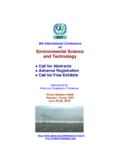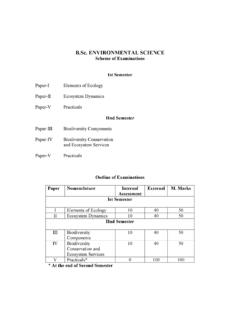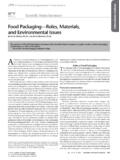Transcription of An Environmental Right for Future Generations - …
1 Science and Environmental Health NetworkThe International Human rights Clinic at Harvard Law SchoolAn Environmental Rightfor Future GenerationsModel State Constitutional Provisions & Model StatuteAn Environmental Right for Future GenerationsModel State Constitutional Provisions & Model StatuteScience and Environmental Health NetworkThe International Human rights Clinic at Harvard Law SchoolNovember 2008 Science & Environmental Health Network ( SEHN ) engages communities and governments in the effective application of science to restore and protect public and ecosystem health. SEHN is a leading proponent of the precautionary principle as a basis for public policy. Our goal is policy reform that promotes just and sustainable communities, for this and Future International Human rights Clinic (IHRC) at Harvard Law School is a center for critical thought and active engagement in human rights . The IHRC provides students the opportunity to engage directly with the vital issues, insti-tutions and processes of the human rights movement.
2 Each year, the IHRC part-ners with dozens of local and international non-governmental organizations to work on human rights projects ranging from litigation, on-site investigations, legal and policy analysis, report drafting for international oversight bodies, and the development of advocacy strategies. Credits and AcknowledgementsThe International Human rights Clinic ( the Clinic ) at Harvard Law School s Human rights Program prepared this document at the request of the Science and Environmental Health Network ( SEHN ). The Introduction was written by Rebecca Agule, 2010. The Model State Constitutional Provisions and Commentary were researched and written by Jason Steffen, 2007, a stu-dent in the Clinic. The Model Statute and Commentary were researched and written by Bart Lounsbury, 2007, a student in the Clinic. Bonnie Docherty, Lecturer on Law and Clinical Instructor at the Clinic, edited the paper and su-pervised the collaborative efforts that led to its creation.
3 Carolyn Raffensperger, Executive Director of SEHN, Joe Guth, Legal Director of SEHN, and Tyler Gi-annini, Clinical Director of the Human rights Program, also helped formulate the ideas in this document, providing additional suggestions and edits. James Cavallaro, Executive Director of the Human rights Program, and Nancy Myers, SEHN Communications Director, assisted with of Contents Introduction 1 Model State Constitutional Provisions 9 Model Statute 15 IntroductIonIn an era of climate change and species extinction, the evidence that human development causes long- as well as short-term Environmental harm is overwhelming. jurisdictions, both state and federal, have adopted regulatory measures to help protect the environment and the humans inhabiting it. Such tools have fallen short, however, of providing necessary protection for Future Generations and their interests in a healthy environment. The Model Constitutional Provisions and Model Statute presented here use substantive and procedural innovations to address the shortcomings of the traditional regulatory approach.
4 The models, which have expanded temporal horizons and also dealt with cumulative harms, represent a means of countering the deficiencies of the current system without replacing it. They recognize the growing concern for the welfare of Future Generations and adapt existing paradigms for that group s benefit by introducing rights -based language and definitions that consider the long-term state of the environment, as well as by creating an ombudsman for Future Legal documents, both international and domestic, endorse principles for protecting the needs and welfare of Future Generations , especially as related to the environment. They have established the foundation upon which the Model Constitution and Statute stand. In an International Court of Justice opinion, Judge Christopher Weeramantry described the respect for Future Generations in indigenous cultures around the In recent decades, legal instruments have increasingly referenced Future Generations .
5 Principle 1 of the Stockholm Declaration, adopted during the 1972 United Nations Conference on the Human Environment, states: [Humanity] bears a solemn responsibility to protect and improve the environment for present and Future Generations . Twenty years later, the Rio Declaration reinforced this concept of owing a duty to all people, both today and in the Future , saying, The Right to development must be fulfilled so as to equitably meet developmental and Environmental needs of present and Future Generations . The 1992 UN 1 For further information on how to protect Future Generations , see Science and Environmental Health Network and The International Human rights Clinic at Harvard Law School, Models for Protecting the environMent for Future Generations (Oct. 2008), available at 2 Gabc kovo-Nagymaros Project (Hung. v. Slovk.), 1997 7, 107 (Sept. 25) (Sep. Op. Weera-mantry), available at 8 .pdf. Stockholm Declaration on the Human Environment of the United Nations Conference on the Human Environment, Jun.
6 16, 1972, 11 1 16, princ. 1. Rio Declaration on Environment and Development, ESCOR, princ. , Doc. A/2 An Environmental Right for Future GenerationsFramework Convention on Climate Change articulates how states parties must work for the benefit of Future Generations : The Parties should protect the climate system for the benefit of present and Future Generations of humankind, on the basis of equity and in accordance with their common but differentiated responsibilities and respective capabilities. 5 These declarations and conventions exemplify how international law has embraced the principle of protecting Future Generations . Domestic law from a variety of countries also enshrines this respect for the needs of Future Generations . Some nations have already included protections in their The Norwegian Constitution states: Every person has a Right to an environment that is conducive to health and to a natural environment whose productivity and diversity are maintained.
7 Natural resources should be managed on the basis of comprehensive long-term considerations whereby this Right will be safeguarded for Future Generations as well. 7 Some jurisdictions also recognize the place of Future Generations . The Indiana State Code describes the purposes of Environmental policy as to preserve, protect, and enhance the quality of the environment so that, to the extent possible, Future Generations will be ensured clean air, clean water, and a healthful environment. 8 Such pieces of domestic legislation further illustrate the legal underpinnings for protecting Future Generations . From an academic perspective, Edith Brown Weiss argues that a rights -based approach provides the best way to protect Future Generations . Weiss s seminal work in the area of intergenerational equity brings rights and Future (Vol. I) (1992) [hereinafter Rio Declaration ].5 UN Framework Convention on Climate Change art. (1), opened for signature May 9, 1992, Doc.
8 7/18 (Part II) (Add. 1), 1 8 8. 6 See const. (1967, as amended 2002), art. 7 (Bol.), available at (according to the text as amended by Law No. 2 10 of August 8, 2002, Every person has the following fundamental rights .. m) to enjoy a healthy environment, ecologically balanced and adequate for his wellbeing, safeguarding the rights of Future Generations . (The original text in Spanish reads, Toda persona tiene los siguientes dere-chos fundamentales: .. m) A gozar de un medio ambiente sano, ecol gicamente equilibrado y adecuado para su bienestar, resguardando los derechos de las generaciones futuras. )). 7 const. (1814, as amended 2007), art. 110(b) (Nor.), available at #fulltext. 8 Ind. Code tit. 1 , art. 12, ch. (1) (2008); see also California Environmental Quality Act, Cal. Pub. Res. Code 21001(e) (2006) (declaring the intent of the state to [c]reate and maintain conditions under which man and nature can exist in productive harmony to fulfill the social and economic requirements of present and Future Generations ); National Environmental Policy Act of 1969, 2 1(a) (2006).
9 An Environmental Right for Future Generations 3generations together. She draws a connection between present actions and Future health and survival, warning that the rights of Future peoples should not be subservient to the needs of those living today. She writes: Future Generations really do have the Right to be assured that we will not pollute ground water, load lake bottoms with toxic wastes, extinguish habitats and species or change the world s climate dramatically all long-term effects that are difficult or impossible to reverse unless there are extremely compelling reasons to do so, reasons that go beyond mere Weiss also cautions against the dangers of detaching the rights of Future Generations from present decision-making processes: If obligations of the present generation are not linked to rights , the present generation has a strong incentive to bias the definition of these obligations in favor of itself at the expense of Future Generations .
10 Intergenerational rights have greater moral force than do obligations. 10 Thus Weiss looks to intergenerational rights as a means of preserving the planet for Future current regulatory system falls short of completely protecting the interests or rights of Future Generations described above. Regulation advances Environmental protection in many ways, such as by setting emissions standards and requiring Environmental impact statements prior to development. It fails, however, adequately to take into account Future Generations or the long-term damage that Environmental degradation can cause. For example, individual polluters may each be in compliance with regulatory standards, but collectively they may be causing harm to a population or ecosystem over the long The Model Constitution and Statute help fill such gaps in the regulatory approach by operationalizing the existing concern for protecting Future Generations interest in a sustainable, healthy environment.







